Business Innovation Report: Solar Power Australia's Competitive Edge
VerifiedAdded on 2021/05/27
|9
|1891
|31
Report
AI Summary
This report provides an executive summary, analyzing the challenges faced by Solar Power Australia in the rapidly growing solar power industry, particularly the increasing competition from new companies offering lower-quality products. The report identifies a decline in customers and sales as key problems and proposes innovative solutions to address them. It suggests enhanced advertisement campaigns and improved product offerings as potential strategies. The report examines the feasibility of these solutions, utilizes the Osterwalder and Pigneur business model for analysis, and highlights critical success factors. The conclusion emphasizes the importance of these strategies for Solar Power Australia's continued growth. The report also includes an introduction, customer/market problem analysis, benefits of the proposed ideas, feasibility studies, and references to support the findings.
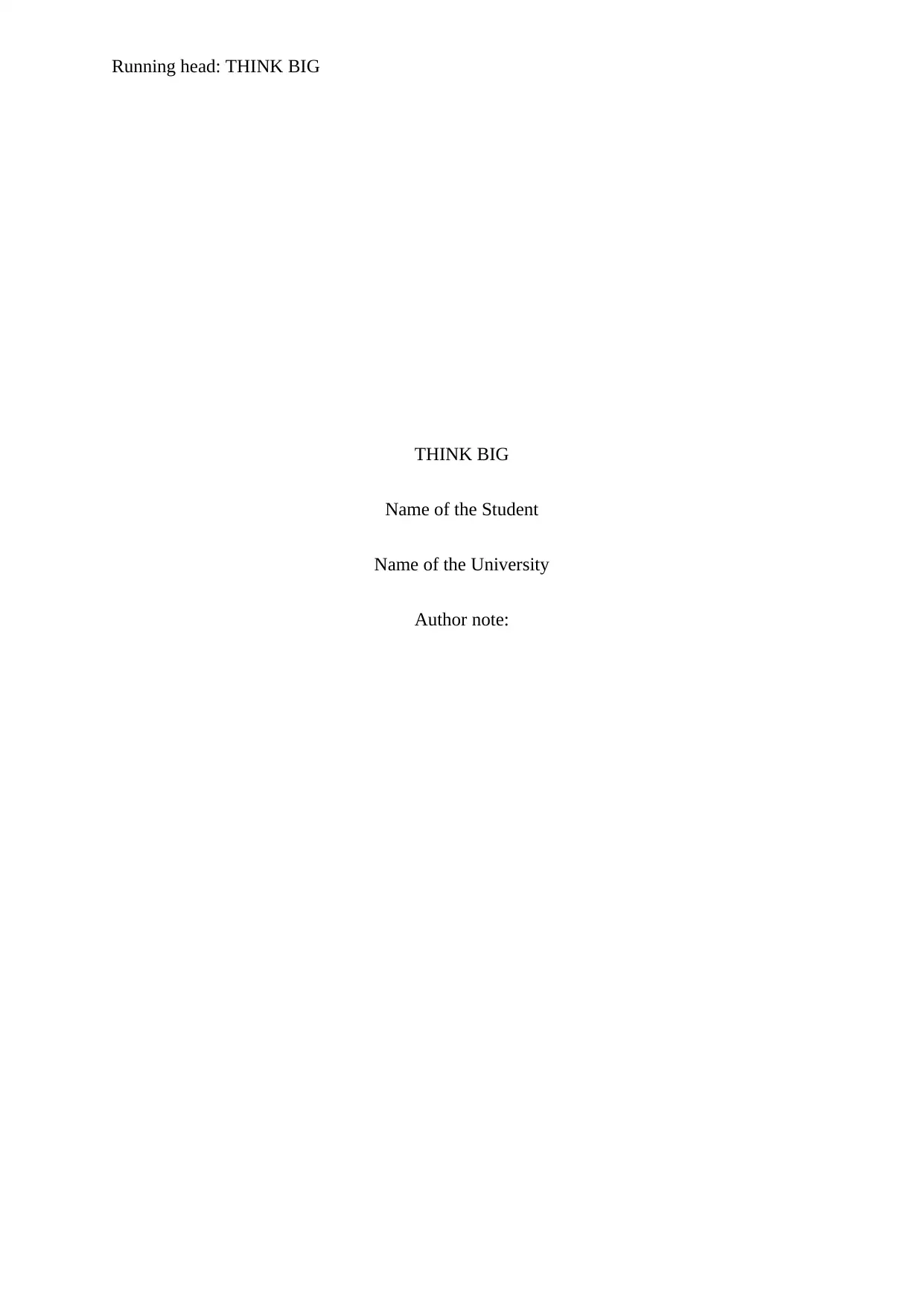
Running head: THINK BIG
THINK BIG
Name of the Student
Name of the University
Author note:
THINK BIG
Name of the Student
Name of the University
Author note:
Paraphrase This Document
Need a fresh take? Get an instant paraphrase of this document with our AI Paraphraser
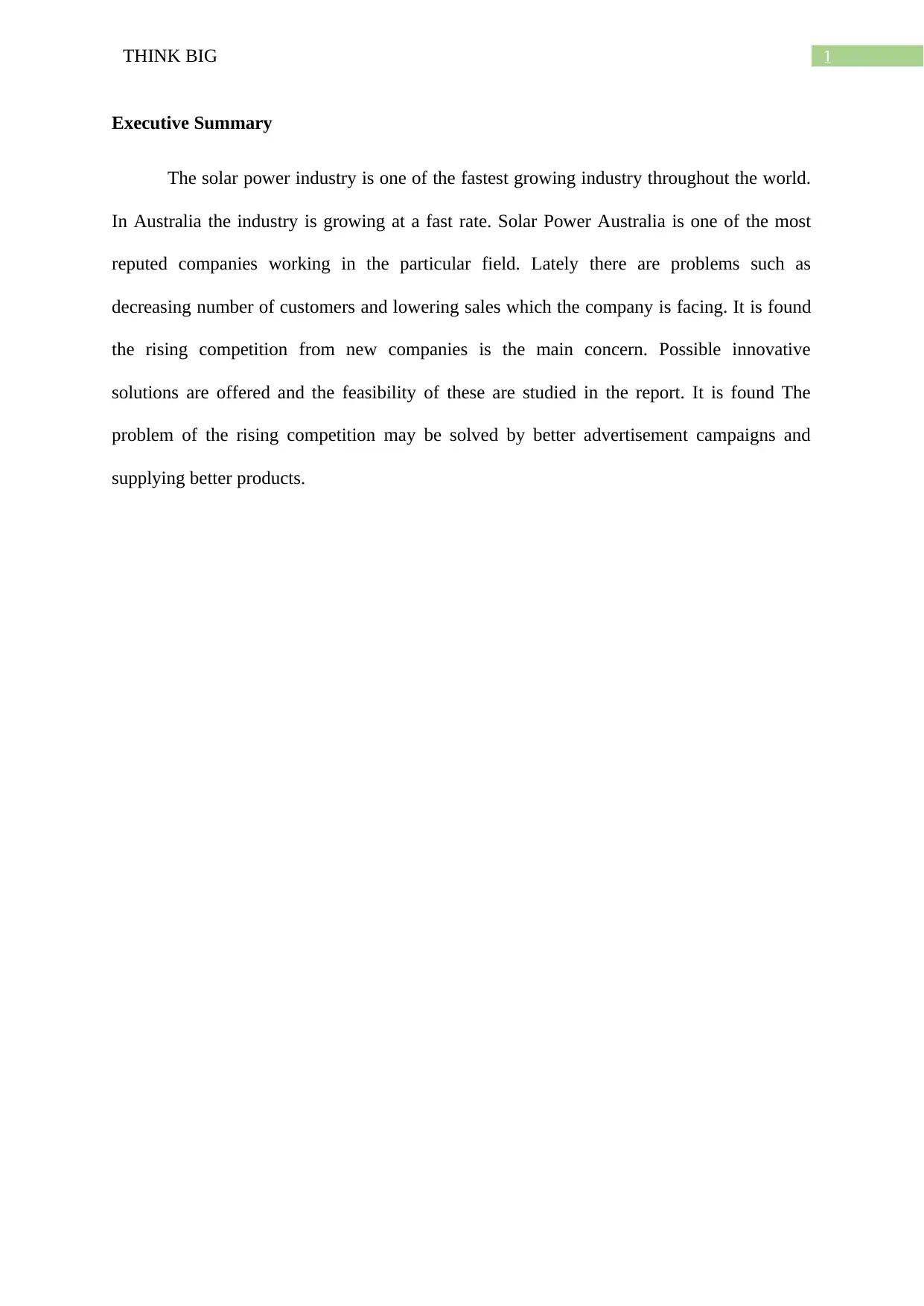
1THINK BIG
Executive Summary
The solar power industry is one of the fastest growing industry throughout the world.
In Australia the industry is growing at a fast rate. Solar Power Australia is one of the most
reputed companies working in the particular field. Lately there are problems such as
decreasing number of customers and lowering sales which the company is facing. It is found
the rising competition from new companies is the main concern. Possible innovative
solutions are offered and the feasibility of these are studied in the report. It is found The
problem of the rising competition may be solved by better advertisement campaigns and
supplying better products.
Executive Summary
The solar power industry is one of the fastest growing industry throughout the world.
In Australia the industry is growing at a fast rate. Solar Power Australia is one of the most
reputed companies working in the particular field. Lately there are problems such as
decreasing number of customers and lowering sales which the company is facing. It is found
the rising competition from new companies is the main concern. Possible innovative
solutions are offered and the feasibility of these are studied in the report. It is found The
problem of the rising competition may be solved by better advertisement campaigns and
supplying better products.
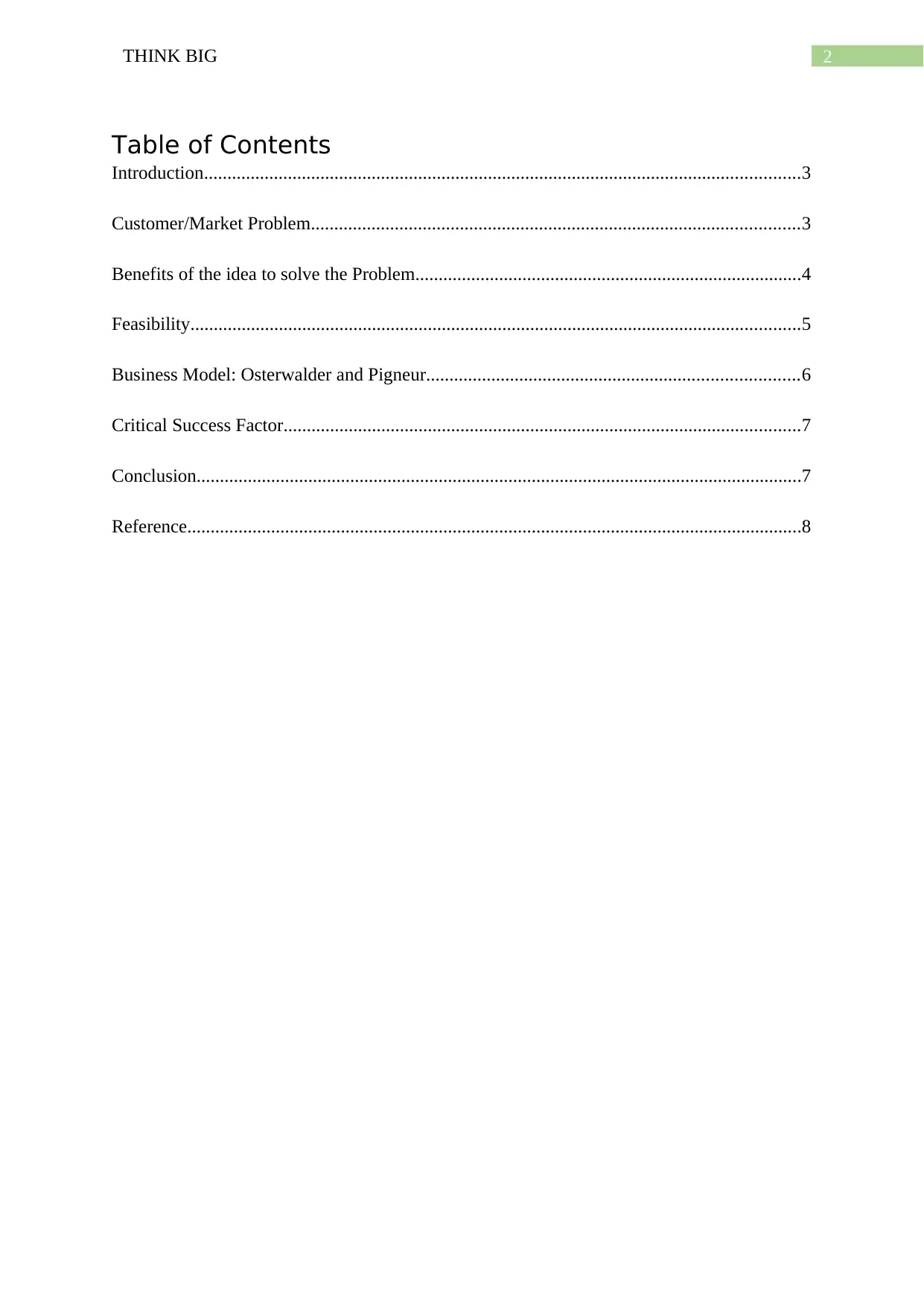
2THINK BIG
Table of Contents
Introduction................................................................................................................................3
Customer/Market Problem.........................................................................................................3
Benefits of the idea to solve the Problem...................................................................................4
Feasibility...................................................................................................................................5
Business Model: Osterwalder and Pigneur................................................................................6
Critical Success Factor...............................................................................................................7
Conclusion..................................................................................................................................7
Reference....................................................................................................................................8
Table of Contents
Introduction................................................................................................................................3
Customer/Market Problem.........................................................................................................3
Benefits of the idea to solve the Problem...................................................................................4
Feasibility...................................................................................................................................5
Business Model: Osterwalder and Pigneur................................................................................6
Critical Success Factor...............................................................................................................7
Conclusion..................................................................................................................................7
Reference....................................................................................................................................8
⊘ This is a preview!⊘
Do you want full access?
Subscribe today to unlock all pages.

Trusted by 1+ million students worldwide
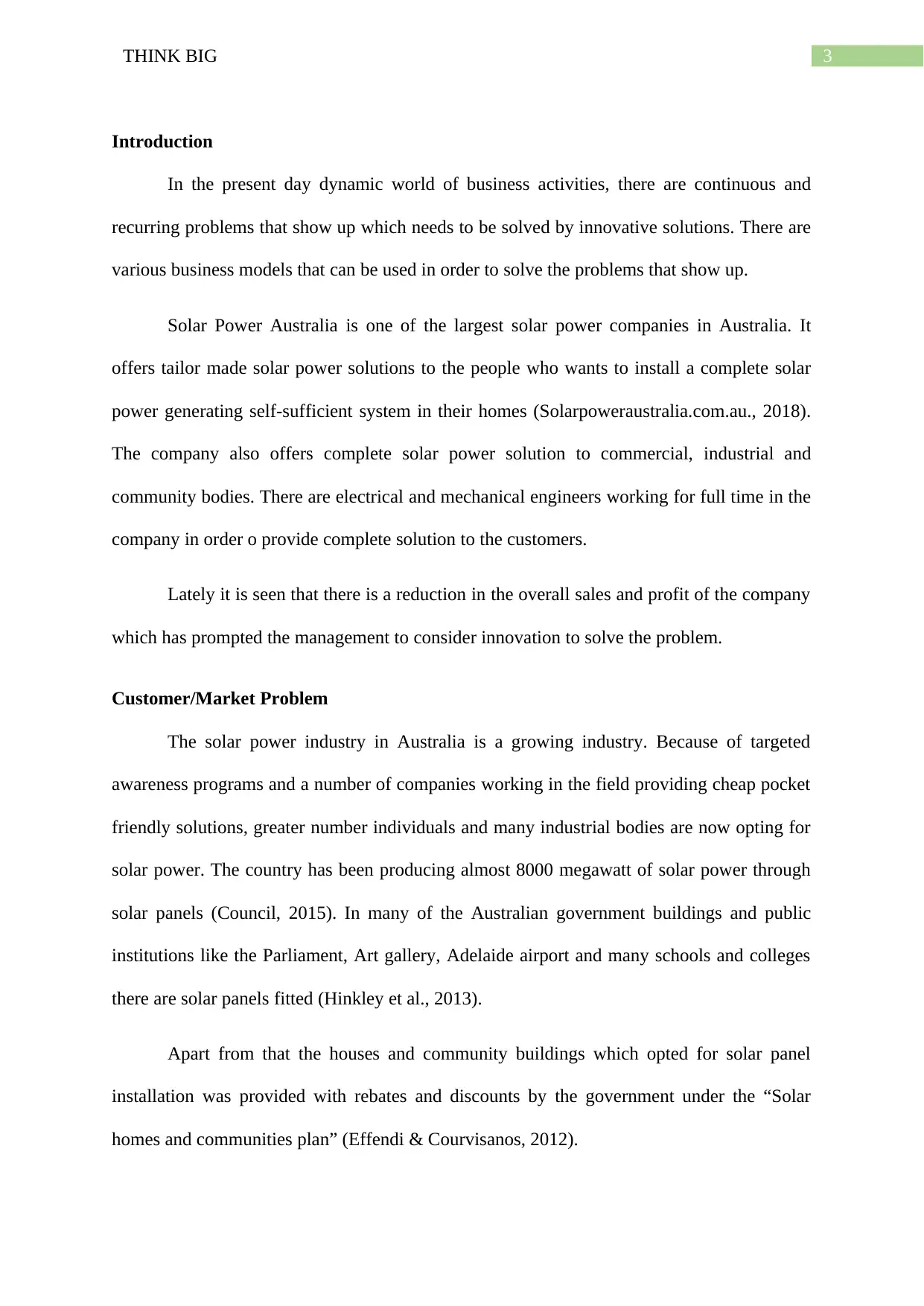
3THINK BIG
Introduction
In the present day dynamic world of business activities, there are continuous and
recurring problems that show up which needs to be solved by innovative solutions. There are
various business models that can be used in order to solve the problems that show up.
Solar Power Australia is one of the largest solar power companies in Australia. It
offers tailor made solar power solutions to the people who wants to install a complete solar
power generating self-sufficient system in their homes (Solarpoweraustralia.com.au., 2018).
The company also offers complete solar power solution to commercial, industrial and
community bodies. There are electrical and mechanical engineers working for full time in the
company in order o provide complete solution to the customers.
Lately it is seen that there is a reduction in the overall sales and profit of the company
which has prompted the management to consider innovation to solve the problem.
Customer/Market Problem
The solar power industry in Australia is a growing industry. Because of targeted
awareness programs and a number of companies working in the field providing cheap pocket
friendly solutions, greater number individuals and many industrial bodies are now opting for
solar power. The country has been producing almost 8000 megawatt of solar power through
solar panels (Council, 2015). In many of the Australian government buildings and public
institutions like the Parliament, Art gallery, Adelaide airport and many schools and colleges
there are solar panels fitted (Hinkley et al., 2013).
Apart from that the houses and community buildings which opted for solar panel
installation was provided with rebates and discounts by the government under the “Solar
homes and communities plan” (Effendi & Courvisanos, 2012).
Introduction
In the present day dynamic world of business activities, there are continuous and
recurring problems that show up which needs to be solved by innovative solutions. There are
various business models that can be used in order to solve the problems that show up.
Solar Power Australia is one of the largest solar power companies in Australia. It
offers tailor made solar power solutions to the people who wants to install a complete solar
power generating self-sufficient system in their homes (Solarpoweraustralia.com.au., 2018).
The company also offers complete solar power solution to commercial, industrial and
community bodies. There are electrical and mechanical engineers working for full time in the
company in order o provide complete solution to the customers.
Lately it is seen that there is a reduction in the overall sales and profit of the company
which has prompted the management to consider innovation to solve the problem.
Customer/Market Problem
The solar power industry in Australia is a growing industry. Because of targeted
awareness programs and a number of companies working in the field providing cheap pocket
friendly solutions, greater number individuals and many industrial bodies are now opting for
solar power. The country has been producing almost 8000 megawatt of solar power through
solar panels (Council, 2015). In many of the Australian government buildings and public
institutions like the Parliament, Art gallery, Adelaide airport and many schools and colleges
there are solar panels fitted (Hinkley et al., 2013).
Apart from that the houses and community buildings which opted for solar panel
installation was provided with rebates and discounts by the government under the “Solar
homes and communities plan” (Effendi & Courvisanos, 2012).
Paraphrase This Document
Need a fresh take? Get an instant paraphrase of this document with our AI Paraphraser
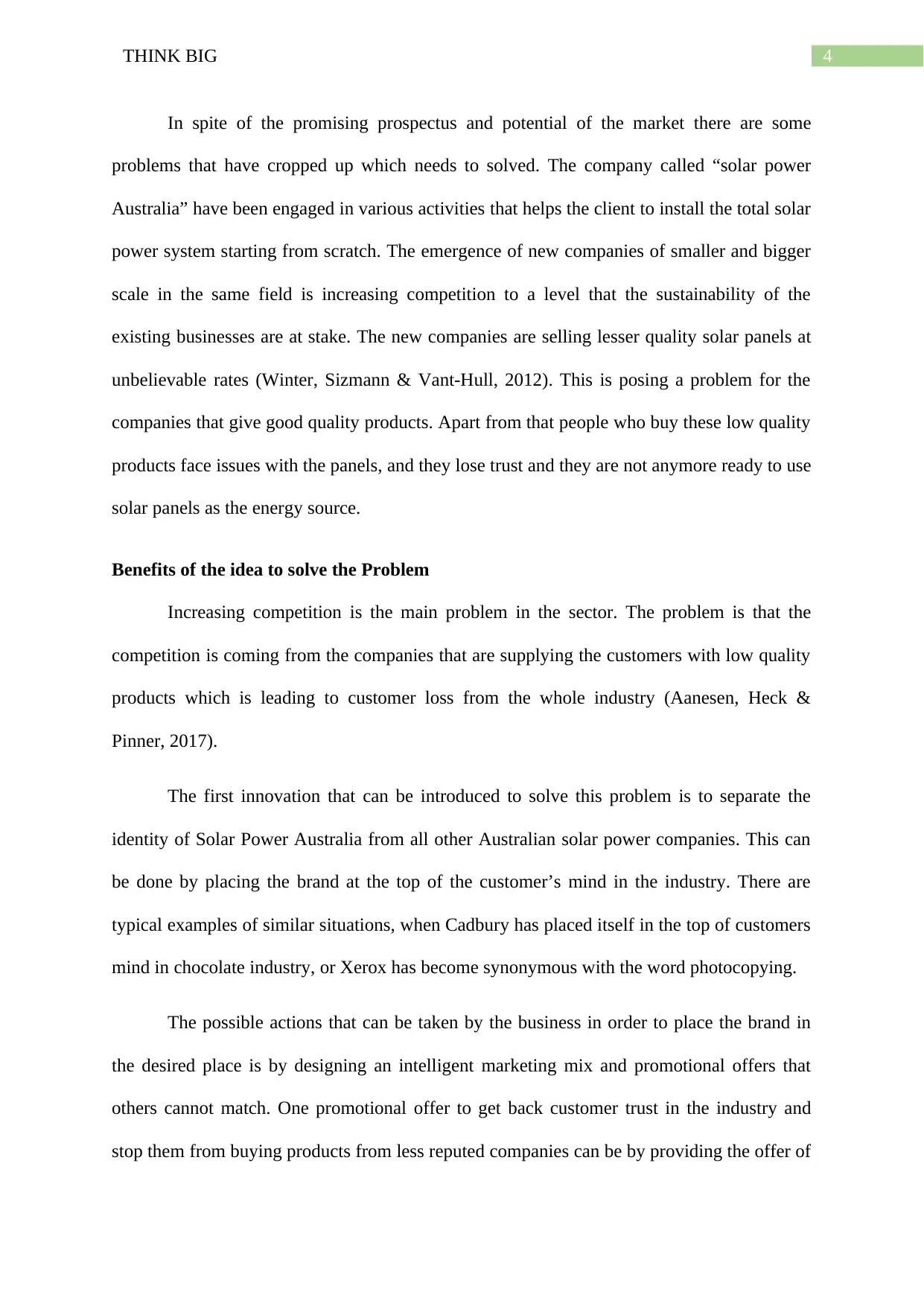
4THINK BIG
In spite of the promising prospectus and potential of the market there are some
problems that have cropped up which needs to solved. The company called “solar power
Australia” have been engaged in various activities that helps the client to install the total solar
power system starting from scratch. The emergence of new companies of smaller and bigger
scale in the same field is increasing competition to a level that the sustainability of the
existing businesses are at stake. The new companies are selling lesser quality solar panels at
unbelievable rates (Winter, Sizmann & Vant-Hull, 2012). This is posing a problem for the
companies that give good quality products. Apart from that people who buy these low quality
products face issues with the panels, and they lose trust and they are not anymore ready to use
solar panels as the energy source.
Benefits of the idea to solve the Problem
Increasing competition is the main problem in the sector. The problem is that the
competition is coming from the companies that are supplying the customers with low quality
products which is leading to customer loss from the whole industry (Aanesen, Heck &
Pinner, 2017).
The first innovation that can be introduced to solve this problem is to separate the
identity of Solar Power Australia from all other Australian solar power companies. This can
be done by placing the brand at the top of the customer’s mind in the industry. There are
typical examples of similar situations, when Cadbury has placed itself in the top of customers
mind in chocolate industry, or Xerox has become synonymous with the word photocopying.
The possible actions that can be taken by the business in order to place the brand in
the desired place is by designing an intelligent marketing mix and promotional offers that
others cannot match. One promotional offer to get back customer trust in the industry and
stop them from buying products from less reputed companies can be by providing the offer of
In spite of the promising prospectus and potential of the market there are some
problems that have cropped up which needs to solved. The company called “solar power
Australia” have been engaged in various activities that helps the client to install the total solar
power system starting from scratch. The emergence of new companies of smaller and bigger
scale in the same field is increasing competition to a level that the sustainability of the
existing businesses are at stake. The new companies are selling lesser quality solar panels at
unbelievable rates (Winter, Sizmann & Vant-Hull, 2012). This is posing a problem for the
companies that give good quality products. Apart from that people who buy these low quality
products face issues with the panels, and they lose trust and they are not anymore ready to use
solar panels as the energy source.
Benefits of the idea to solve the Problem
Increasing competition is the main problem in the sector. The problem is that the
competition is coming from the companies that are supplying the customers with low quality
products which is leading to customer loss from the whole industry (Aanesen, Heck &
Pinner, 2017).
The first innovation that can be introduced to solve this problem is to separate the
identity of Solar Power Australia from all other Australian solar power companies. This can
be done by placing the brand at the top of the customer’s mind in the industry. There are
typical examples of similar situations, when Cadbury has placed itself in the top of customers
mind in chocolate industry, or Xerox has become synonymous with the word photocopying.
The possible actions that can be taken by the business in order to place the brand in
the desired place is by designing an intelligent marketing mix and promotional offers that
others cannot match. One promotional offer to get back customer trust in the industry and
stop them from buying products from less reputed companies can be by providing the offer of
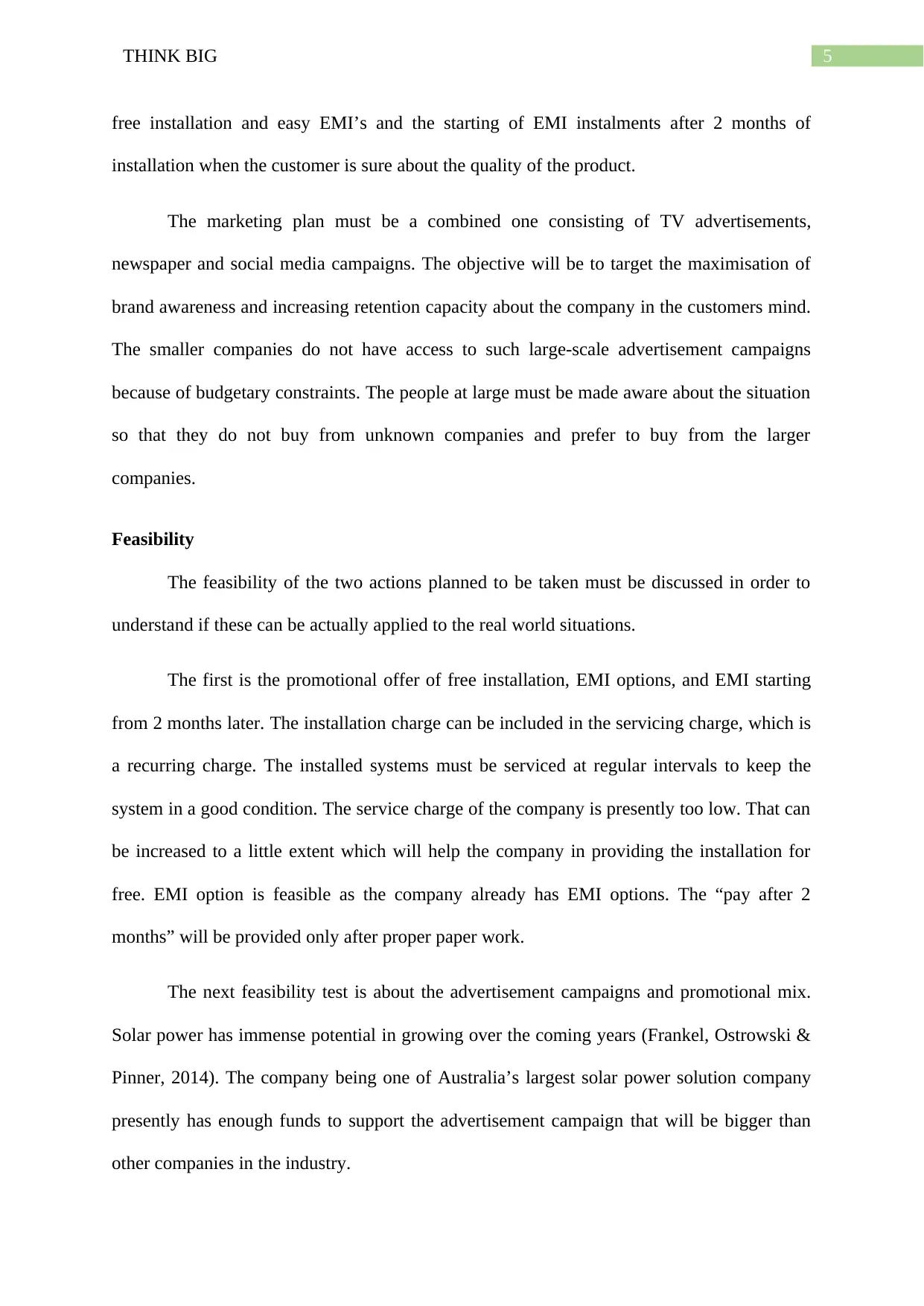
5THINK BIG
free installation and easy EMI’s and the starting of EMI instalments after 2 months of
installation when the customer is sure about the quality of the product.
The marketing plan must be a combined one consisting of TV advertisements,
newspaper and social media campaigns. The objective will be to target the maximisation of
brand awareness and increasing retention capacity about the company in the customers mind.
The smaller companies do not have access to such large-scale advertisement campaigns
because of budgetary constraints. The people at large must be made aware about the situation
so that they do not buy from unknown companies and prefer to buy from the larger
companies.
Feasibility
The feasibility of the two actions planned to be taken must be discussed in order to
understand if these can be actually applied to the real world situations.
The first is the promotional offer of free installation, EMI options, and EMI starting
from 2 months later. The installation charge can be included in the servicing charge, which is
a recurring charge. The installed systems must be serviced at regular intervals to keep the
system in a good condition. The service charge of the company is presently too low. That can
be increased to a little extent which will help the company in providing the installation for
free. EMI option is feasible as the company already has EMI options. The “pay after 2
months” will be provided only after proper paper work.
The next feasibility test is about the advertisement campaigns and promotional mix.
Solar power has immense potential in growing over the coming years (Frankel, Ostrowski &
Pinner, 2014). The company being one of Australia’s largest solar power solution company
presently has enough funds to support the advertisement campaign that will be bigger than
other companies in the industry.
free installation and easy EMI’s and the starting of EMI instalments after 2 months of
installation when the customer is sure about the quality of the product.
The marketing plan must be a combined one consisting of TV advertisements,
newspaper and social media campaigns. The objective will be to target the maximisation of
brand awareness and increasing retention capacity about the company in the customers mind.
The smaller companies do not have access to such large-scale advertisement campaigns
because of budgetary constraints. The people at large must be made aware about the situation
so that they do not buy from unknown companies and prefer to buy from the larger
companies.
Feasibility
The feasibility of the two actions planned to be taken must be discussed in order to
understand if these can be actually applied to the real world situations.
The first is the promotional offer of free installation, EMI options, and EMI starting
from 2 months later. The installation charge can be included in the servicing charge, which is
a recurring charge. The installed systems must be serviced at regular intervals to keep the
system in a good condition. The service charge of the company is presently too low. That can
be increased to a little extent which will help the company in providing the installation for
free. EMI option is feasible as the company already has EMI options. The “pay after 2
months” will be provided only after proper paper work.
The next feasibility test is about the advertisement campaigns and promotional mix.
Solar power has immense potential in growing over the coming years (Frankel, Ostrowski &
Pinner, 2014). The company being one of Australia’s largest solar power solution company
presently has enough funds to support the advertisement campaign that will be bigger than
other companies in the industry.
⊘ This is a preview!⊘
Do you want full access?
Subscribe today to unlock all pages.

Trusted by 1+ million students worldwide
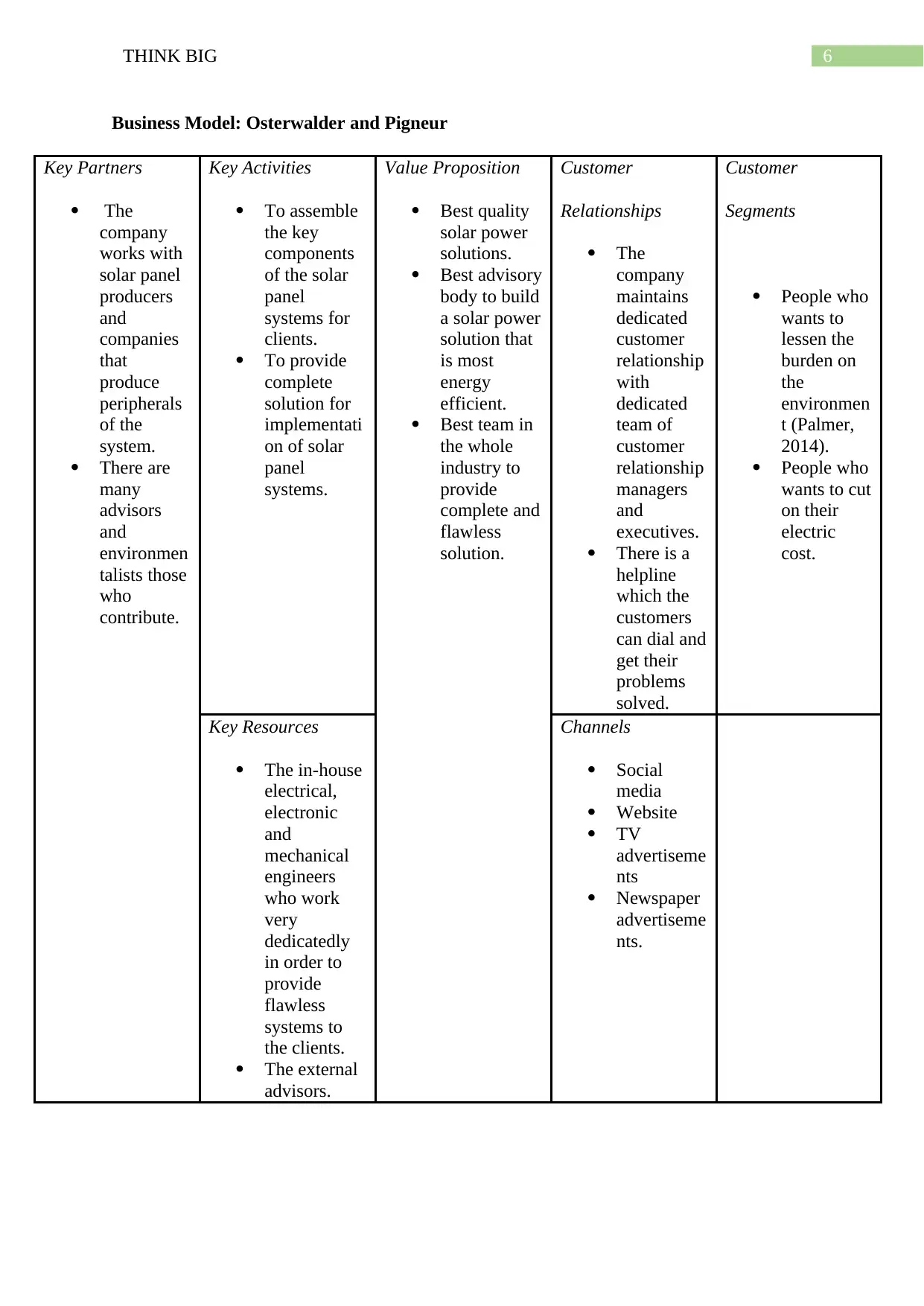
6THINK BIG
Business Model: Osterwalder and Pigneur
Key Partners
The
company
works with
solar panel
producers
and
companies
that
produce
peripherals
of the
system.
There are
many
advisors
and
environmen
talists those
who
contribute.
Key Activities
To assemble
the key
components
of the solar
panel
systems for
clients.
To provide
complete
solution for
implementati
on of solar
panel
systems.
Value Proposition
Best quality
solar power
solutions.
Best advisory
body to build
a solar power
solution that
is most
energy
efficient.
Best team in
the whole
industry to
provide
complete and
flawless
solution.
Customer
Relationships
The
company
maintains
dedicated
customer
relationship
with
dedicated
team of
customer
relationship
managers
and
executives.
There is a
helpline
which the
customers
can dial and
get their
problems
solved.
Customer
Segments
People who
wants to
lessen the
burden on
the
environmen
t (Palmer,
2014).
People who
wants to cut
on their
electric
cost.
Key Resources
The in-house
electrical,
electronic
and
mechanical
engineers
who work
very
dedicatedly
in order to
provide
flawless
systems to
the clients.
The external
advisors.
Channels
Social
media
Website
TV
advertiseme
nts
Newspaper
advertiseme
nts.
Business Model: Osterwalder and Pigneur
Key Partners
The
company
works with
solar panel
producers
and
companies
that
produce
peripherals
of the
system.
There are
many
advisors
and
environmen
talists those
who
contribute.
Key Activities
To assemble
the key
components
of the solar
panel
systems for
clients.
To provide
complete
solution for
implementati
on of solar
panel
systems.
Value Proposition
Best quality
solar power
solutions.
Best advisory
body to build
a solar power
solution that
is most
energy
efficient.
Best team in
the whole
industry to
provide
complete and
flawless
solution.
Customer
Relationships
The
company
maintains
dedicated
customer
relationship
with
dedicated
team of
customer
relationship
managers
and
executives.
There is a
helpline
which the
customers
can dial and
get their
problems
solved.
Customer
Segments
People who
wants to
lessen the
burden on
the
environmen
t (Palmer,
2014).
People who
wants to cut
on their
electric
cost.
Key Resources
The in-house
electrical,
electronic
and
mechanical
engineers
who work
very
dedicatedly
in order to
provide
flawless
systems to
the clients.
The external
advisors.
Channels
Social
media
Website
TV
advertiseme
nts
Newspaper
advertiseme
nts.
Paraphrase This Document
Need a fresh take? Get an instant paraphrase of this document with our AI Paraphraser
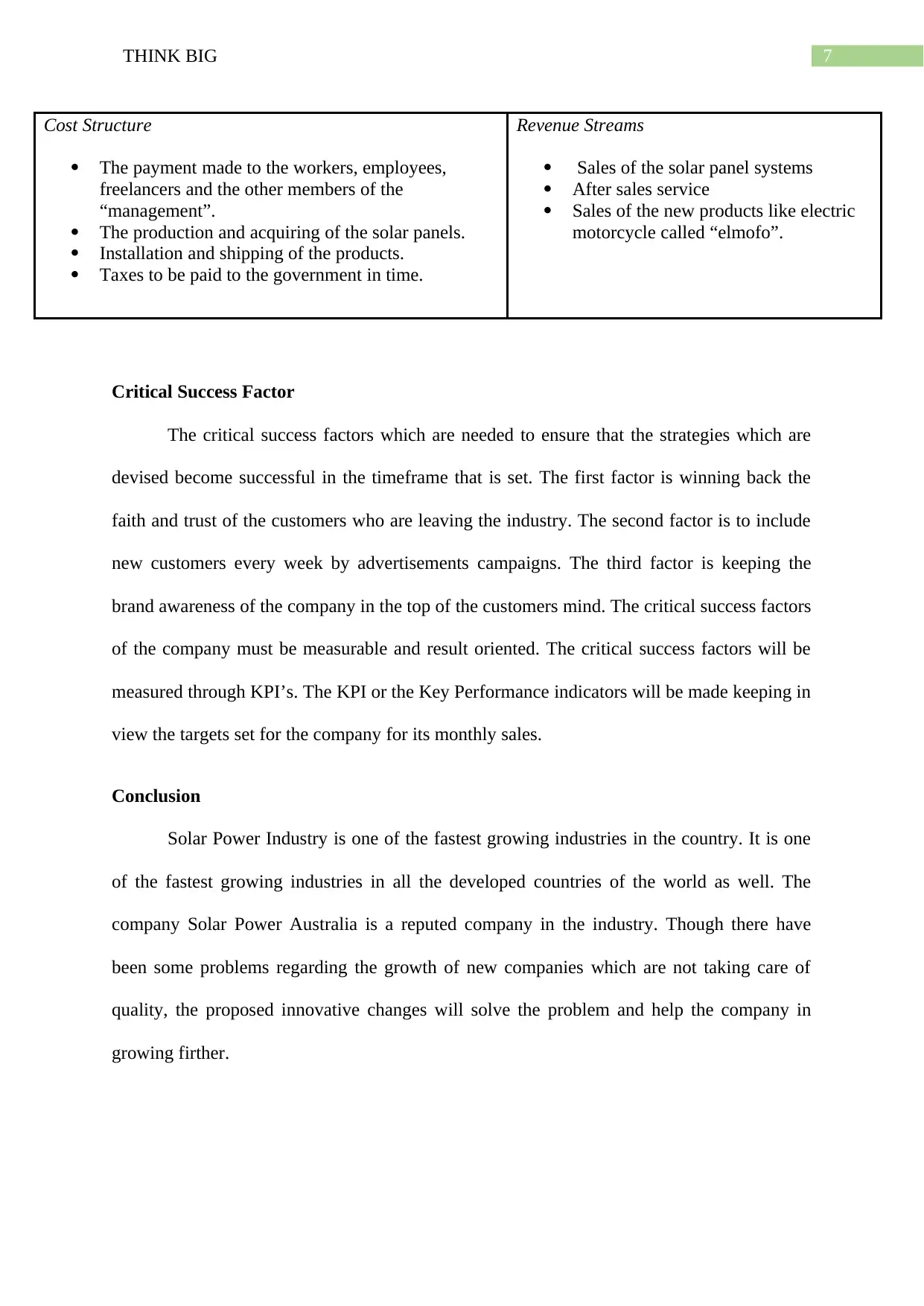
7THINK BIG
Cost Structure
The payment made to the workers, employees,
freelancers and the other members of the
“management”.
The production and acquiring of the solar panels.
Installation and shipping of the products.
Taxes to be paid to the government in time.
Revenue Streams
Sales of the solar panel systems
After sales service
Sales of the new products like electric
motorcycle called “elmofo”.
Critical Success Factor
The critical success factors which are needed to ensure that the strategies which are
devised become successful in the timeframe that is set. The first factor is winning back the
faith and trust of the customers who are leaving the industry. The second factor is to include
new customers every week by advertisements campaigns. The third factor is keeping the
brand awareness of the company in the top of the customers mind. The critical success factors
of the company must be measurable and result oriented. The critical success factors will be
measured through KPI’s. The KPI or the Key Performance indicators will be made keeping in
view the targets set for the company for its monthly sales.
Conclusion
Solar Power Industry is one of the fastest growing industries in the country. It is one
of the fastest growing industries in all the developed countries of the world as well. The
company Solar Power Australia is a reputed company in the industry. Though there have
been some problems regarding the growth of new companies which are not taking care of
quality, the proposed innovative changes will solve the problem and help the company in
growing firther.
Cost Structure
The payment made to the workers, employees,
freelancers and the other members of the
“management”.
The production and acquiring of the solar panels.
Installation and shipping of the products.
Taxes to be paid to the government in time.
Revenue Streams
Sales of the solar panel systems
After sales service
Sales of the new products like electric
motorcycle called “elmofo”.
Critical Success Factor
The critical success factors which are needed to ensure that the strategies which are
devised become successful in the timeframe that is set. The first factor is winning back the
faith and trust of the customers who are leaving the industry. The second factor is to include
new customers every week by advertisements campaigns. The third factor is keeping the
brand awareness of the company in the top of the customers mind. The critical success factors
of the company must be measurable and result oriented. The critical success factors will be
measured through KPI’s. The KPI or the Key Performance indicators will be made keeping in
view the targets set for the company for its monthly sales.
Conclusion
Solar Power Industry is one of the fastest growing industries in the country. It is one
of the fastest growing industries in all the developed countries of the world as well. The
company Solar Power Australia is a reputed company in the industry. Though there have
been some problems regarding the growth of new companies which are not taking care of
quality, the proposed innovative changes will solve the problem and help the company in
growing firther.
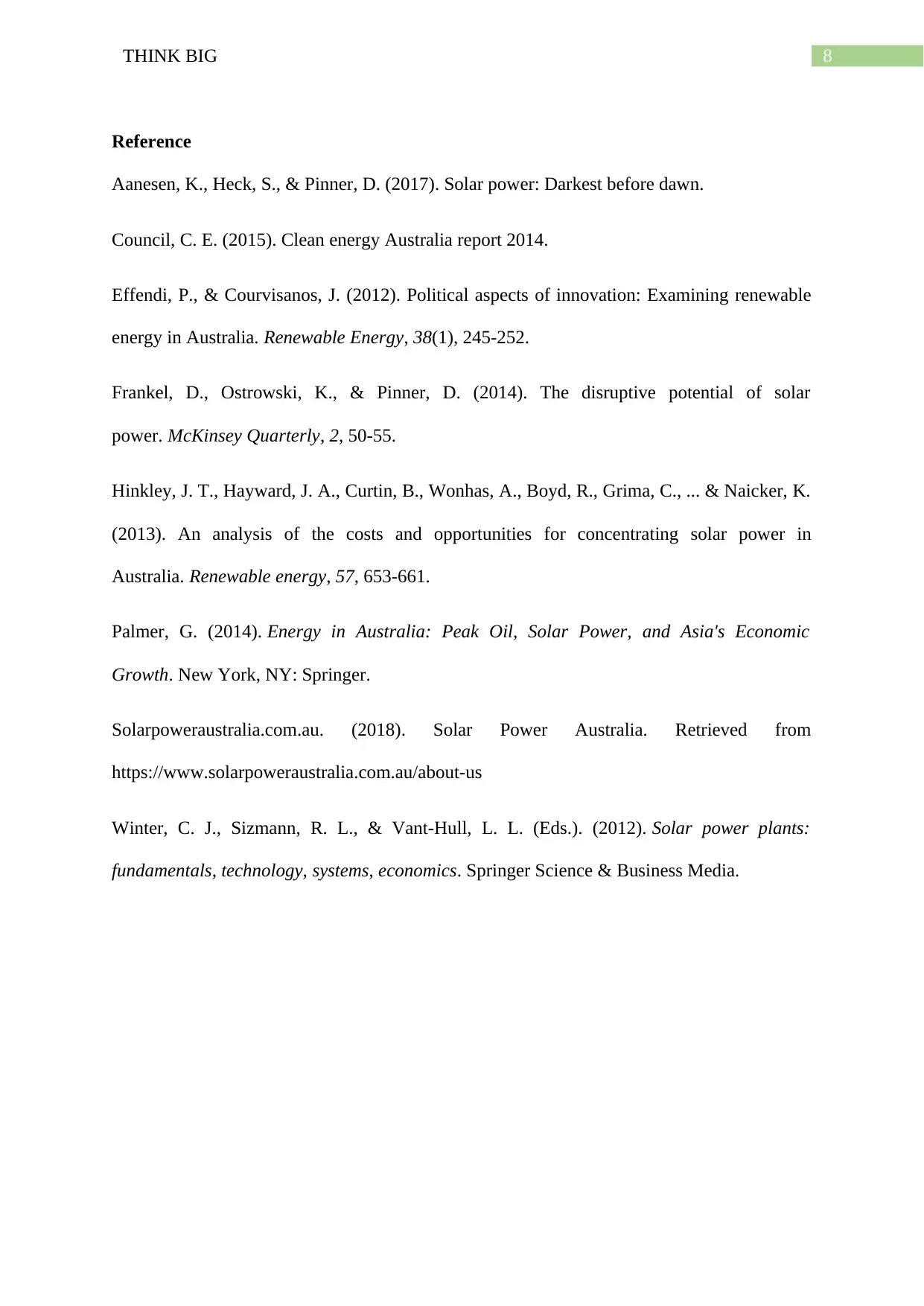
8THINK BIG
Reference
Aanesen, K., Heck, S., & Pinner, D. (2017). Solar power: Darkest before dawn.
Council, C. E. (2015). Clean energy Australia report 2014.
Effendi, P., & Courvisanos, J. (2012). Political aspects of innovation: Examining renewable
energy in Australia. Renewable Energy, 38(1), 245-252.
Frankel, D., Ostrowski, K., & Pinner, D. (2014). The disruptive potential of solar
power. McKinsey Quarterly, 2, 50-55.
Hinkley, J. T., Hayward, J. A., Curtin, B., Wonhas, A., Boyd, R., Grima, C., ... & Naicker, K.
(2013). An analysis of the costs and opportunities for concentrating solar power in
Australia. Renewable energy, 57, 653-661.
Palmer, G. (2014). Energy in Australia: Peak Oil, Solar Power, and Asia's Economic
Growth. New York, NY: Springer.
Solarpoweraustralia.com.au. (2018). Solar Power Australia. Retrieved from
https://www.solarpoweraustralia.com.au/about-us
Winter, C. J., Sizmann, R. L., & Vant-Hull, L. L. (Eds.). (2012). Solar power plants:
fundamentals, technology, systems, economics. Springer Science & Business Media.
Reference
Aanesen, K., Heck, S., & Pinner, D. (2017). Solar power: Darkest before dawn.
Council, C. E. (2015). Clean energy Australia report 2014.
Effendi, P., & Courvisanos, J. (2012). Political aspects of innovation: Examining renewable
energy in Australia. Renewable Energy, 38(1), 245-252.
Frankel, D., Ostrowski, K., & Pinner, D. (2014). The disruptive potential of solar
power. McKinsey Quarterly, 2, 50-55.
Hinkley, J. T., Hayward, J. A., Curtin, B., Wonhas, A., Boyd, R., Grima, C., ... & Naicker, K.
(2013). An analysis of the costs and opportunities for concentrating solar power in
Australia. Renewable energy, 57, 653-661.
Palmer, G. (2014). Energy in Australia: Peak Oil, Solar Power, and Asia's Economic
Growth. New York, NY: Springer.
Solarpoweraustralia.com.au. (2018). Solar Power Australia. Retrieved from
https://www.solarpoweraustralia.com.au/about-us
Winter, C. J., Sizmann, R. L., & Vant-Hull, L. L. (Eds.). (2012). Solar power plants:
fundamentals, technology, systems, economics. Springer Science & Business Media.
⊘ This is a preview!⊘
Do you want full access?
Subscribe today to unlock all pages.

Trusted by 1+ million students worldwide
1 out of 9
Related Documents
Your All-in-One AI-Powered Toolkit for Academic Success.
+13062052269
info@desklib.com
Available 24*7 on WhatsApp / Email
![[object Object]](/_next/static/media/star-bottom.7253800d.svg)
Unlock your academic potential
Copyright © 2020–2025 A2Z Services. All Rights Reserved. Developed and managed by ZUCOL.





